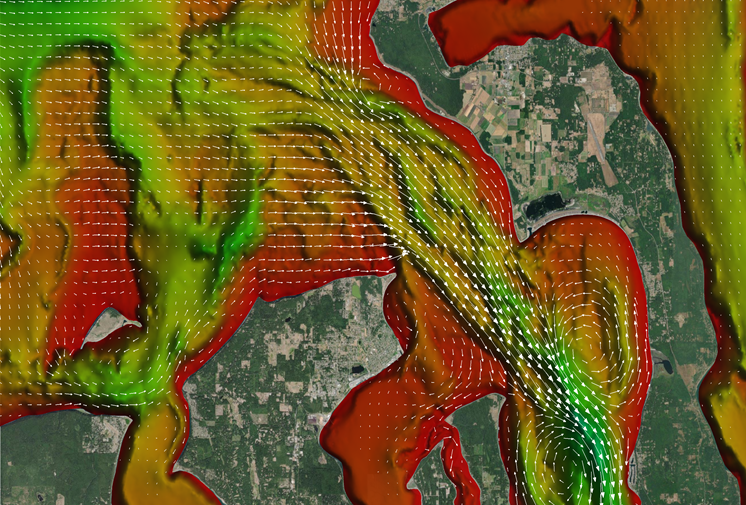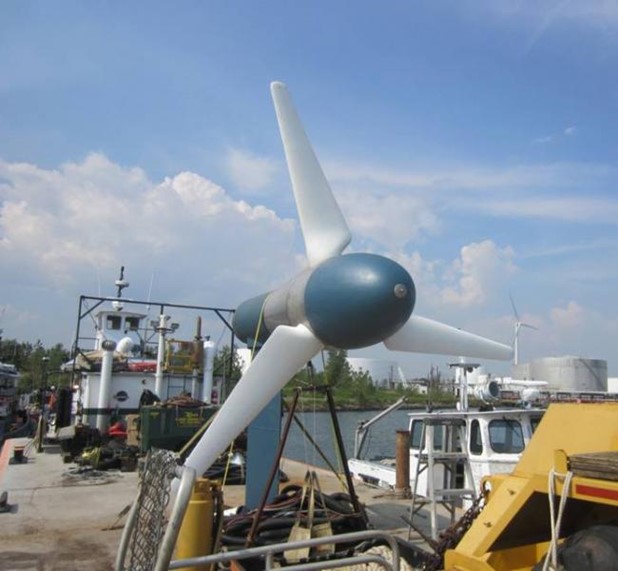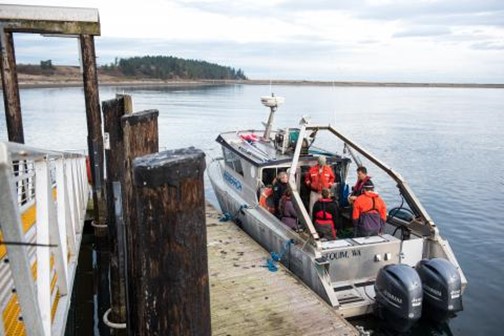Tidal Energy
What is tidal energy?
Tidal energy is a form of power produced by the natural rise and fall of tides caused by the gravitational interaction between Earth, the sun, and the moon. Tidal currents with sufficient energy for harvesting occur when water passes through a constriction, causing the water to move faster. Using specially engineered generators in suitable locations, tidal energy can be converted into useful forms of power, including electricity. Other forms of energy can also be generated from the ocean, including waves, persistent ocean currents, and the differences in temperature and salinity in seawater.
Suitable locations for capturing tidal energy include those with large differences in tidal range, which is the difference between high tide and low tides, and where tidal channels and waterways become smaller and tidal currents become stronger.
As worldwide demand for clean electricity, renewable fuels, and critical materials for energy and industrial processes grows, it is crucial to identify and secure sustainable energy resources beyond what is currently available. Researchers recognize the vast potential of the ocean to produce reliable, renewable energy for a variety of uses. The Water Power Technologies Office of the Department of Energy (DOE) estimates that energy from waves, tides, and ocean currents have the combined potential to generate enough electricity to power millions of homes.
Because water is denser than air, tidal energy is more powerful than wind energy, producing exponentially more power at the same turbine diameter and rotor speed. Tidal power is also more predictable and consistent than wind or solar energy, both of which are intermittent and less predictable. This makes tidal energy an intriguing renewable energy source to pursue. The challenge is in making it commercially feasible to capture and convert the energy into usable power at scale, as well as finding uses of tidal energy where costs are less sensitive than national grid electricity.
To fully harness tidal energy as a significant and ongoing source of clean energy, it is critical that researchers explore ways to assist in developing technologies and methods that increase its viability for broad commercial application. The industry is largely just emerging, with complex barriers to overcome before it can sustainably grow and thrive.

History of tidal energy
People in Europe first used tidal energy to operate grain mills more than 1,000 years ago. Incoming tidewater was retained in storage ponds and the outgoing tidal movement was used to turn waterwheels to mill grain. This process of using falling water and spinning turbines to create electricity was introduced in the 19th century.
Early attempts at tidal power plants incorporated a dam-like barrage approach. However, this has not ultimately remained the focus of industry.
Four early feasibility studies for large-scale tidal power plants were conducted in the United States and Canada between 1924 and 1977 by the U.S. Power Commission, Nova Scotia Light and Power, and the U.S. and Canadian governments, respectively. All were focused on specific geographic locations around border areas between Maine and Canada. While conclusions varied regarding economic feasibility, they did not yield significant progress.
A large tidal barrage was built in La Rance, France in 1966 and still operates today with 240 megawatts (MW) of electricity generation capacity, the largest in the world until 2011, when an array with 254 MW capacity opened in South Korea.
In the past two decades, the industry has turned toward in-stream tidal energy generation, where a single device or groups (or arrays) of devices are placed within the tidal stream. The European Marine Energy Centre, established in 2003, is the world’s largest facility for testing and demonstrating wave and tidal technologies in real sea conditions. The facility, which has grid-connected test sites for larger prototypes and scale test sites for smaller devices, has facilitated testing of more tidal energy devices than any other site in the world.
Why does tidal energy matter?
Tidal energy represents a significant opportunity to increase the world’s renewable power generation capacity. As countries continue to develop, and the global population and its reliance on energy grows, so does the demand on power systems to provide additional clean energy resources. Tidal energy could potentially supply a significant percentage of future electricity needs if barriers, including robustness of devices, environmental challenges, and the cost-effectiveness of its commercial application, can be successfully navigated.
Tidal energy is best captured in areas with high tidal ranges and strong currents. There are several ways to harness it.
Tidal turbines can be installed in places with strong tidal activity, either floating or on the sea floor, individually or in arrays. They look and operate much like wind turbines, using blades to turn a rotor that powers a generator, but must be significantly more robust given their operating environment and, as tidal turbines are much smaller than large wind turbines, more turbines are required to produce the same amount of energy. Multiple tidal demonstration projects are under way in the United States.
Turbines placed in tidal streams capture energy from the current, and underwater cables transmit it to the grid. Tidal stream systems can capture energy at sites with high tidal velocities created by land constrictions, such as in straits or inlets. When fully operational, the MeyGen project in Scotland will be the largest tidal stream generating station in the world, with up to 398 MW generation capacity.
Tidal barrages are like dams built across tidal rivers, bays, and estuaries to form a tidal basin. Turbines inside the barrage enable the basin to fill during incoming tides and release through the system during outgoing tides, generating electricity in both directions. It operates much like a river dam in capturing the power in surrounding water. Two of the world’s largest tidal power stations are barrages in South Korea and France, with 254 MW and 240 MW electricity generation capacity, respectively. The next largest in Canada has much lower generation capacity at 20 MW.
Tidal lagoons are like barrages in using man-made retaining walls to partially contain a large volume of incoming tidal water, with embedded turbines to capture its energy. They also rely on a large tidal range to generate power. Unlike barrages, tidal lagoons could be placed along natural coastline for continuous power generation as the tide changes and designed to minimize their environmental footprint. Though the energy output from tidal lagoons is unproven, with no current examples in operation, a few are under development in China, North Korea, and the United Kingdom. Due to the environmental challenges they pose, tidal barrages and lagoons are not the focus of tidal energy development efforts in most areas of the world.
The predominant application for tidal energy has been the generation of electricity for use on shore via the national power grid. There is also potential value in tidal energy to serve the needs of other existing or emerging ocean industries (e.g., aquaculture, ocean mineral mining, oceanographic research, or military missions), as captured in DOE’s Powering the Blue Economy Initiative. The “blue economy” is defined as the sustainable use of ocean resources for economic growth, improved livelihoods, and jobs, while preserving the health of ocean ecosystems.

Benefits of tidal energy
Tidal energy is a clean, renewable, sustainable resource that is underutilized and represents significant opportunity to meet growing global energy needs, both now and in the future. Water is hundreds of times denser than air, which makes tidal energy more powerful than wind. It is more efficient than wind or solar energy due to its relative density and produces no greenhouse gases or other waste, making it an attractive renewable energy source to pursue.
Also beneficial is the relative predictability and reliability of continuous tides, especially compared to other renewable energy sources like wind and solar, which are affected by the variability and uncertainty of atmospheric forcing. Low tide and high tide cycles are easy to predict and rarely experience unexpected changes.
To realize the benefits of tidal energy on a commercial scale, it will be important for researchers to identify new technologies and methods that significantly lower installation and maintenance costs, reduce environmental effects, and increase the suitability of more locations. There are a few tidal projects in operation; however, the industry is growing slowly due to barriers to entry and lack of supply chain.
Limitations of tidal energy
Tidal energy as an industry remains limited by a few significant barriers, cost being its most challenging. Developing tidal arrays and connecting them to the power grid requires extensive and costly engineering and manufacturing work. While there are numerous tidal technologies being tested that may improve affordability, none have emerged as a market leader that could help establish supply chains and begin reducing installation and maintenance costs.
Tidal energy technologies have been slow to develop, and some industry participants have exited the market. Suitable locations for tidal energy facilities are inherently limited, given that not all coastal bays and tidal channels experience the conditions required for effective power generation. And among those limited locations, some are not near the grid, requiring further investment to install lengthy undersea cables for transmitting generated electricity.
In addition to cost and geographic limitations, there is also significant concern about environmental effects. Constructing and operating tidal energy arrays based on massive underwater structures may change the ambient flow field and water quality, as well as negatively affect sea life and their habitats, potentially threatening collisions by marine animals and fish with rotating turbine blades and affecting marine animal navigation and communication with underwater noise. This may cause some sensitive species to shy away from electromagnetic fields from power cables or changes to their habitats.
Achieving cost reductions, developing devices that can endure ocean forces, and minimizing environmental effects to improve tidal energy’s commercial viability is and must be the primary focus of research investments in this area.
Recent advances in tidal energy
Tidal power arrays of varying sizes are being developed or have been deployed recently around the world, with much focus on energy generation from tidal streams or currents. A tidal stream array located in the Pentland Firth in Scotland—the body of water between the Scottish mainland and the northern islands—is the newest to begin operating and is the first of its kind. The MeyGen tidal energy project began phased operations in 2018, and its first four turbines had generated and delivered more than 35 gigawatt-hours of power to the grid by the end of 2020. At full deployment, 61 turbines submerged on the seabed will generate up to 400 MW of energy from high-speed currents in the area.
There are multiple projects under way in Wales, an emerging hotspot for the industry. This development will include a top center for marine engineering, which was approved by the United Kingdom and Welsh governments in 2020 and will include among its assets a 90-kilometer demonstration zone to enable the deployment of future tidal energy generation technologies.
There are other test sites and technology deployments at various stages in countries including Scotland, France, Japan, Korea, China, Canada, and the United States as developers bring forward new and improved tidal current technologies that show promise for clearing key hurdles to commercial viability. The ability to assess the performance and environmental effects of new technologies in real sea conditions is critical to sustainable industry advancement.
Engineers are working to improve tidal energy generation technologies to increase their energy production efficiency, reduce biofouling, decrease their environmental effects, and find a path to commercial profitability.
Tidal energy at PNNL
Researchers at PNNL are studying tidal hydrodynamics and developing sophisticated models to help understand and characterize tidal energy resources, simulate their extraction by various types of tidal turbines, and assess potential environmental effects—to water quality, fish migration, and sediment disturbance, for instance. The results from these studies can inform site selection for tidal energy generation installations, assist with estimating resource requirements for tidal energy projects, inform technology advancement, and support international standards development.
At the PNNL Marine and Coastal Research Laboratory, researchers are working to address significant barriers to broad applications of tidal energy resources, from commercialization to Powering the Blue Economy. The industry requires access to testing facilities to advance technologies before maturing them for deployment. Through the Triton Initiative and the U.S. Testing Expertise and Access for Marine Energy Research Program, PNNL lends technical expertise and facilities for the study of tidal energy technologies under development and the potential risks associated with their use. For more than a decade, PNNL has led the Ocean Energy Systems-Environmental (OES-Environmental) Initiative, bringing together 16 countries to assess environmental effects of marine energy to remove permitting barriers. The Triton Initiative works synergistically with OES-Environmental to research methods and identify instruments for measuring environmental effects.
Another important focus of PNNL’s efforts related to tidal energy is to organize and connect knowledge within the research community, marine energy industry, the blue economy, and other interested stakeholders. In fact, PNNL developed Tethys and Tethys Engineering to offer collaborative virtual research spaces with access to pertinent databases and knowledge hubs, and is helping develop a data repository for research and development activities in this area. Both are part of a larger system led by PNNL called PRIMRE (Portal and Repository for Marine Renewable Energy), which encompasses all of the U.S. data and information associated with marine energy.
In addition to significant modeling and data-driven work, researchers at PNNL are also studying materials of potential interest for helping reduce costs while increasing material durability and lifespan and controlling biofouling in tidal installations.

